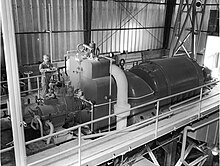BORAX experiments
BORAX experiments ( Bo iling R e a ctor e x periments), a series of reactor experiments in the Idaho National Laboratory called (USA), with which in the 1950s, the stability behavior of boiling water reactors was investigated.
The technology of light water reactors was still in its infancy in the 1950s. As for the boiling water type, it was not known how bubbles in the reactor core would affect the stability of the operating behavior. It was known that compressing the bubbles by increasing the pressure in the reactor system increases the criticality in terms of core physics , the reactor becomes supercritical and thus unstable. The experiments have shown, however, that long-term stable operating behavior is possible and that the reactor only tends to overcriticality at certain points, which can usually be compensated for by the negative vapor bubble coefficient , i.e. H. by the fact that after the performance excursionin the form of an undesirable increase in nuclear fission due to stronger bubble formation in the water moderator , the output is reduced again immediately.
The climax of the experiments with the BORAX-I reactor was a destructive test in which a total loss of the plant was accepted. Explosive charges were attached to the shutdown rods. The resulting sudden ejection of the rods from the reactor led to a sudden performance excursion, which, however, thanks to the above-mentioned Doppler effect, did not lead to a total destruction of the plant. However, the consequences had still been underestimated: it was expected that only a few fuel elements would melt , but had to be aware that a large part of the entire reactor core had melted.
swell
- ANL-W History - Reactors (BORAX-I) ( Memento from February 5, 2006 in the Internet Archive ) (English)
